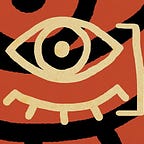Graphic Design — Nippon Kobo — Ayao Yamana 1934
This piece is the first cover of ‘Nippon Kobo’ which was made in 1934 by Ayao Yamana. Nippon Kobo was originally a group first established by Japanese photographers Natori Konosuke and Kimura Ihee, photography critic Ina Nobuo, graphic designer Hara Hiromu, movie actor and planner Okada Sozo and a few others. The group distributed their photographs and in addition to that, they mounted exhibitions, the first one being in 1933, which featured the work of Kimura Ihee, and then the next year they mounted a photojournalism exhibition. Although the group was having success with their exhibitions they encountered a confrontation within the group which caused the group to split. Kimura and Harra were not happy with the group and decided to leave in May 1934 to establish Chuo Kobo (Metropolitan Studio).
In October of that year Natori Konosuke reorganised Nippon Kobo (Japanese Studio) and began publishing Nippon, a quarterly propaganda magazine aimed at international audiences. The magazine was made to attract over-seas readers, to increase tourism, while also being a state-supported tool to enhance Japan’s image among international audiences. It featured a very stylised Japan, with lots of focus on realist photography, symbolic graphics, typography and text, to narrate stories of Japan. There was lots of focus on Japanese handicraft and Japanese women. The magazine was of such a high quality, even for todays standards, and first rank graphic designers Ayao Yamana and Kono Takashi worked on the magazine. Even though the magazine was going strong, due to the rise of militarism in Japan, the magazine changed its name from Nippon Kobo to Kokusai Hodo Kogei (International Press Technology) and moved the base of the magazine to Shanghai, where it became more heavily involved in propaganda activities for the military. The magazine was disbanded at the end of the war due to it no longer being necessary.
This cover features a highly stylised paper doll in traditional Japanese clothing, which is superimposed onto a photograph on modern architecture in black and white. It visualises the combination of modernity and tradition through the contrast in design. This combination was really relevant at the time due to a lot of Westernisation in Japan. The fragile paper doll could represent Japan as a country at the time with the modernised strong buildings representing the West and possibly even the rest of the world.
The colours used in this piece are very traditional Japanese colours, the deep reds and turquoise colours. They stand out in this piece and highlight different parts of the design. The red creates an passionate feel to the doll, especially since the lipstick matches the same colour as the attire the doll is dressed in, and gives the doll a more fragile feel to it. War was approaching for Japan and they knew it.
The cover was designed by Ayao Yamana who was a highly ranked and respected Graphic Designer. His graphic design career spanned over 5 decades and he was very well known for his elegant and delicate illustrations and designs. This design was quite different to his usual designs which usually featured lots of well-placed lines in delicate and intricate ways to create shapes and were very visually appealing.
This was the first cover of Nippon. It had to make an impact and it had to make viewers want to pick up and read the magazine. I think as a design it works. To me, the colours would be the thing that would make me want to pick it up. They are vibrant and completely contrast with the plain black and white background of the buildings. The magazine was also targeted at people in the other seven countries in whose language it is printed in. So therefore the audience for this design is much wider than just Japan. This means that the design had to entice people who speak Japanese, English, Chinese (both simplified and traditional), French, Spanish, Arabic and Russian. I think the use of the traditional style Japanese doll works well to entice people to pick up the magazine. I think the doll creates a sort of logo or image associated with Japan and therefore people are seeing it and automatically have an idea of what the magazine features. This works really well as ‘branding’ or ‘marketing’ as the with the strong Japanese imagery, people already know what it is.
I really like this design as a whole. I believe it fits its purpose, which makes for a good design, otherwise the design would’ve been pointless. I also think it looks aesthetically pleasing as I like the colours that are used, and that they go really well with each other. The design clearly entices people to pick it up and read it as the magazine did so well when it first began publishing and I feel this is the reason why this design is successful and does its job.
